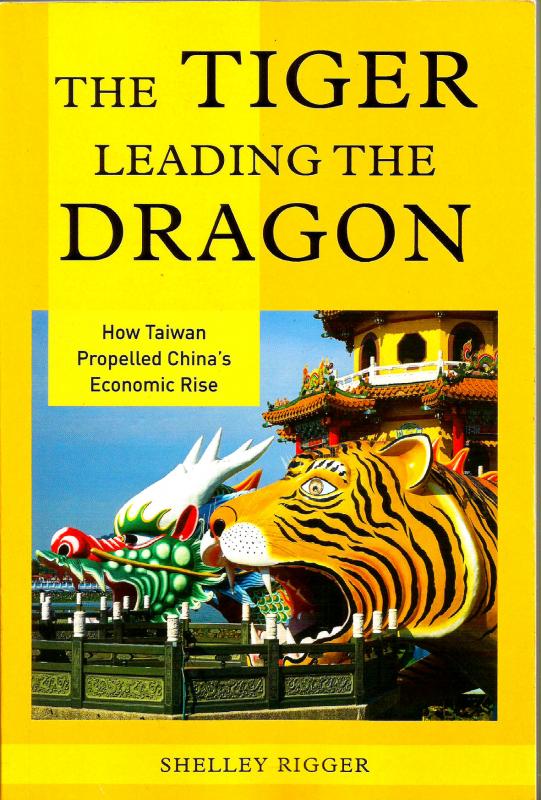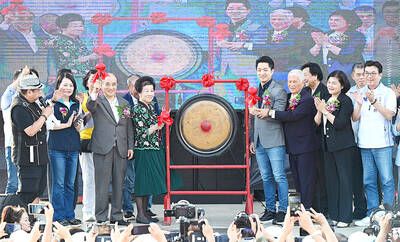After World War II, Taiwan began climbing the economic ladder, rising from the “banana kingdom” to the “shoe kingdom.” US shoe brand Nike led the way, moving much of its manufacturing to Taiwan from Japan at the start of the 1980s. But Taiwanese factories quickly came to do much more than simply stitch together Air Jordans.
For Nike and many other international brands, Taiwanese came to manage the entire supply chain and production process, including dozens of subcontractor factories. And later on, when labor became expensive in Taiwan, Taiwanese retained their niche as contract manufacturers by moving their factories to a newly opened China, where they became known as taishang (台商), “Taiwanese businessmen.”
A recent book, The Tiger Leading the Dragon: How Taiwan Propelled China’s Economic Rise, by US-based academic Shelley Rigger, offers a concise history of business across the Taiwan Strait, beginning with the bold assertion that “without taishang, the PRC economy as we know it today would not exist.”

‘MADE IN TAIWAN’
The story begins in the 1980s, when the “Made in Taiwan” mark became a global icon. Anonymous sounding companies like the Pou Chen Group (寶成國際集團) and Feng Tay (豐泰企業) produced for Nike and virtually every major brand of athletic shoes; the Futai Group (福太洋傘) became the world’s largest maker of umbrellas, partnering with Totes; China General Plastics Corporation (華夏塑膠) made half the world’s supply of Barbie Dolls for Mattel; Pretty Fashion Inc (the company is registered in Taiwan with an English name) produced a quarter of the wedding dresses sold in Europe.
The Pou Chen Group no longer manufactures many shoes in Taiwan, but it is still the world’s largest producer of athletic shoes, making 300 million shoes per year for Nike, Asics, Reebok, Adidas, UnderArmour and Puma, according to the author and the PCG Web site. Founded in Taiwan in 1969, the company has moved its manufacturing with the times from Taiwan in the 1980s to China in the 1990s, and then on to South and Southeast Asia in recent decades.
Taiwanese manufacturers’ special genius, Rigger tells us, was for adding value in a very odd place — the middle of the supply chain. By innovating on key components and methods of production — and more importantly filing a huge number of patents on these inventions — they were able to become indispensable partners to (mostly) Western brands and at the same time chase cheap labor through other developing Asian markets. Their ability to take care of everything, from supply chain management to research and development for better manufacturing processes, cemented their value in the global economy, both then and now.
The world’s most famous contract manufacturers today are still Taiwanese. Taiwan Semiconductor Manufacturing Co (TSMC, 台積電) produces half the world’s computer chips and has been called “the world’s most important company.” Foxconn is famous for manufacturing the iPhone and other Apple products.
Both are also perfect examples of mid-supply-chain dominance, with technologies and supply networks so formidable that their closest competitors would require years of development to catch them.
Both also have significant operations in China. Foxconn is China’s largest employer with over 1 million workers, while TSMC is more cautiously engaged, operating only two of 12 chip foundries in China and keeping its cutting edge technology in Taiwan.
In 1987, Taiwan’s government allowed its citizens to visit China for the first time since 1949. It began a process of political engagement, moving from basics like direct mail and telephone service in the 1990s, then moving to direct flights and investment mechanisms in the 2000s.
Just as these doors began opening, taishang, who were losing the ability to compete on price in Taiwan, flocked to China in the early 1990s.
Interestingly, most taishang were ethnic Taiwanese and not “mainlanders,” or waishengren, a cohort who’d come to Taiwan with Chiang Kai-shek (蔣介石) in 1949. Though waishengren generally had personal connections in China, in Taiwan they’d become entrenched in government bureaucracies. Ethnic Taiwanese were in many ways second class citizens without access to the government’s “iron rice bowl.” So they turned instead to business.
During the 1990s, entire clusters of Taiwanese factories moved to China, sometimes almost overnight. It was a “second spring” for Taiwanese manufacturing and resulted in new “Little Taiwans,” or factory cities, throughout China, especially in Dongguan (near Guangzhou), Kunshan (near Shanghai) and Xiamen (directly across from Kinmen). The migration was so formidable that Kunshan’s local government, for example, created an administrative bureau set up purely for dealing with Taiwanese businesses.
At first, taishang mostly did business with each other. They hired Taiwanese managers, avoided joint ventures with Chinese firms and kept local Chinese at arm’s length, protecting their methods and technologies.
It was not until the mid-2000s that local Chinese factories fought their way into supply chains previously dominated by Taiwanese. Rigger argues that taishang, who accounted for 83 percent of China’s direct foreign investment in 2000, nevertheless taught China — which entered the world economy in the early 1980s with inefficient and internationally naive state-run enterprises — the tricks of doing business with the world. It is one of several key points in the book that seems generally correct but could be more convincingly fleshed out.
CULTURAL UNIQUENESS OF ‘TAISHANG’
Another such point is the taishang’s cultural “uniqueness,” which Rigger describes early on as a tradition of “black-hand boss” (i.e. they got their hands dirty) from a nation of small and medium enterprises, where no one would work for someone else if they could help it (even now, there is roughly one business for every eight Taiwanese adults).
Later on, she backtracks somewhat, describing the taishang of the 1990s as merely “harvesting low-hanging fruit” by moving into a virgin economy that was up for grabs. Yet later, the taishang of 2010 no longer seemed so unique: Chinese contract manufacturers with better local guanxi (關係 “relationships”) began beating them at their own game. The pupil had overtaken the teacher.
Looking back at China’s rise, perhaps it would be safer to say that just as the world’s largest market was getting ready to industrialize and globalize, it was the Taiwanese who had the closest linguistic, cultural, historical and blood ties to China. Moreover, politics opened the doors at a time when Taiwan’s economic boom was starting to fade, and taishang were desperate to “cost down.” Simply put, Taiwanese businessmen were in the right place at the right time.
The Tiger Leading the Dragon deserves credit for piecing together an interesting history of cross-strait business and cultural relations. But it is not a deep dive, seldom going beyond general-interest journalism and speaking all too often in broad terms. In the book’s latter half, discussions of historical context are frustratingly redundant.
END OF THE CHINA GOLD RUSH
Yet the book is timely, because for Taiwan and most of the world, the China gold rush is over. In 2005, China launched a five year plan to win back its economy from foreign investors, and 2025 has been set as a target for China to develop world-leading firms in semiconductors and other high tech. China’s leader Xi Jinping (習近平) further aims to diminish foreign cultural and media influence, even if it is Taiwanese.
Taiwan’s government has during this same span reinforced limits on cross-strait flows, including outgoing technologies and incoming investments.
Still, Taiwanese continue to do business with and in China in a very big way. Rigger concludes, saying, “the era of breakneck integration and mutual benefit has come to an end.” Breakneck integration is certainly finished. But given the complexity of the relationship, mutual benefit remains an open question.
If you prefer listening to reading, Rigger gave an excellent overview of the book on the China-focused podcast, Sinica (www.supchina.com) in its Oct. 14, 2021 edition.

The 1990s were a turbulent time for the Chinese Nationalist Party’s (KMT) patronage factions. For a look at how they formed, check out the March 2 “Deep Dives.” In the boom years of the 1980s and 1990s the factions amassed fortunes from corruption, access to the levers of local government and prime access to property. They also moved into industries like construction and the gravel business, devastating river ecosystems while the governments they controlled looked the other way. By this period, the factions had largely carved out geographical feifdoms in the local jurisdictions the national KMT restrained them to. For example,

April 14 to April 20 In March 1947, Sising Katadrepan urged the government to drop the “high mountain people” (高山族) designation for Indigenous Taiwanese and refer to them as “Taiwan people” (台灣族). He considered the term derogatory, arguing that it made them sound like animals. The Taiwan Provincial Government agreed to stop using the term, stating that Indigenous Taiwanese suffered all sorts of discrimination and oppression under the Japanese and were forced to live in the mountains as outsiders to society. Now, under the new regime, they would be seen as equals, thus they should be henceforth

With over 100 works on display, this is Louise Bourgeois’ first solo show in Taiwan. Visitors are invited to traverse her world of love and hate, vengeance and acceptance, trauma and reconciliation. Dominating the entrance, the nine-foot-tall Crouching Spider (2003) greets visitors. The creature looms behind the glass facade, symbolic protector and gatekeeper to the intimate journey ahead. Bourgeois, best known for her giant spider sculptures, is one of the most influential artist of the twentieth century. Blending vulnerability and defiance through themes of sexuality, trauma and identity, her work reshaped the landscape of contemporary art with fearless honesty. “People are influenced by

The remains of this Japanese-era trail designed to protect the camphor industry make for a scenic day-hike, a fascinating overnight hike or a challenging multi-day adventure Maolin District (茂林) in Kaohsiung is well known for beautiful roadside scenery, waterfalls, the annual butterfly migration and indigenous culture. A lesser known but worthwhile destination here lies along the very top of the valley: the Liugui Security Path (六龜警備道). This relic of the Japanese era once isolated the Maolin valley from the outside world but now serves to draw tourists in. The path originally ran for about 50km, but not all of this trail is still easily walkable. The nicest section for a simple day hike is the heavily trafficked southern section above Maolin and Wanshan (萬山) villages. Remains of